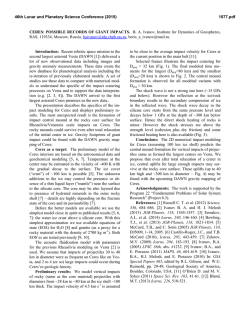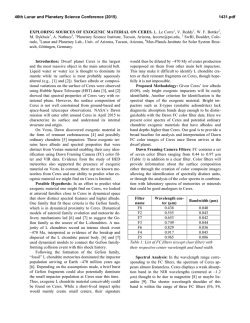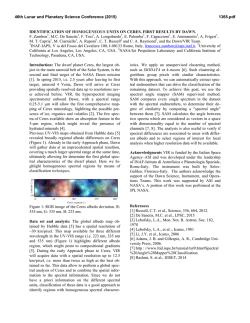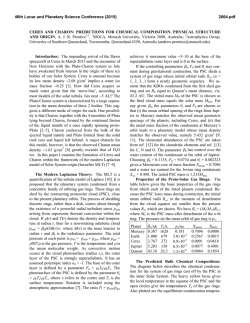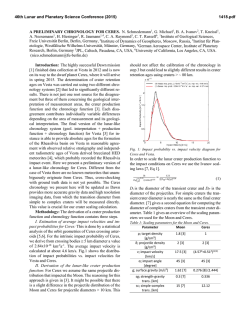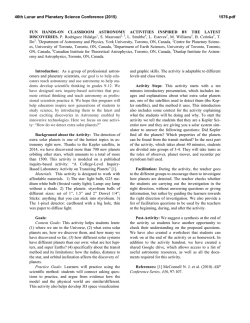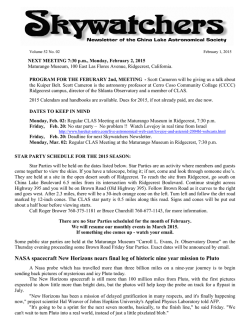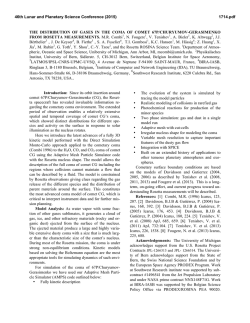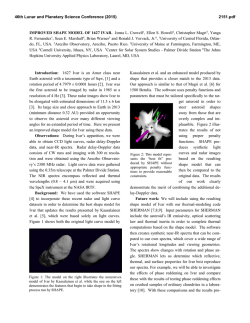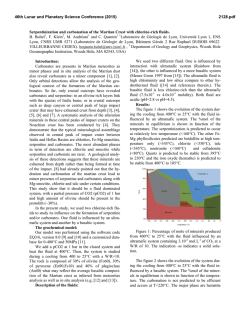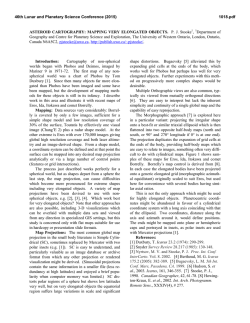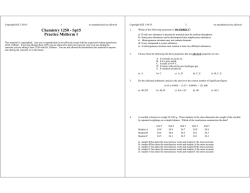
Modeling the Aqueous Geochemistry of Ceres and Other Dwarf
46th Lunar and Planetary Science Conference (2015) 2526.pdf MODELING THE AQUEOUS GEOCHEMISTRY OF CERES AND OTHER DWARF PLANETS. M. Neveu1 , S. J. Desch1 , and J. C. Castillo-Rogez2 . 1 School of Earth and Space Exploration, Arizona State University, Tempe, AZ 85287, USA. 2 Jet Propulsion Laboratory, California Institute of Technology, Pasadena, CA 91109, USA. ([email protected]). Dwarf Planets in the Spotlight: 2015 will see the first exploration of dwarf planets by spacecraft, withDawn scheduled to enter Ceres’ orbit in April and New Horizons to fly through the Pluto system in July. Motivated by these imminent visits, we have previously modeled the possible thermal and geophysical evolution of these worlds. We have found their interiors likely to be differentiated into a rocky core and hydrosphere, possibly harboring subsurface liquid water over geological timescales [1-4]. These findings concur with observations of hydrated minerals on Ceres’ surface [5] and raise the possibility of cryovolcanism on dwarf planets, compatible with detections of water vapor at Ceres [6] and ammonia dihydrate, seemingly recently emplaced, on Pluto’s moon Charon [7]. The long-term presence of liquid water in contact with a rocky core suggests that water-rock interactions may occur. These seem necessary to explain Ceres’ surface minerals, and can produce species such as H2 or N2 whose exsolution may drive explosive cryovolcanism [8]. Interactions may be favored by extensive core fracturing: our models have shown that Ceres’ core could be cracked to at least 10% by volume, up to 100%. Thus, aqueous alteration of the core may have taken place at a water:rock ratio near Ceres’ bulk ratio. Geochemistry Matters: Water-rock reactions can feed back on the thermal evolution of dwarf planets in several ways. Rock hydration may result in a ten-fold change in its thermal conductivity at a given T , and cause a 30% increase in core volume [2,4]. Here, we investigate two other prominent geochemical feedbacks not yet captured in our evolution models: Fate of antifreezes. The extent and duration through which liquid persists depends strongly on the presence of volatiles (NH3 , CH3 OH) and salts, which depress its melting temperature. Volatile antifreezes, likely accreted by dwarf planets [1,2,8], may be oxidized to N2 or carbonates, removing all or part of antifreeze capabilities. Conversely, salts may be leached from the core. Fate of radionuclides. The long-lived heat producing elements K, Th, and U, present in the rocky core, may be leached into the fluid, taking away part of the core’s radiogenic fuel [9-11]. # 1 2 3 4 5 6 7 8 Rock OC OC OC CM CM CM CM CM W:R 0.42 1.46 1.46 0.18 0.18 0.18 0.18 0.05 T(o C) 50 50 50 300 50 50 175 175 P(bar) 1000 1000 1000 500 1000 1000 1000 1000 pH pe 10 FMQ 10 FMQ 10 FMQ-1 12 FMQ 10 FMQ 13 FMQ 12 FMQ 12 FMQ Table 1: Parameter sets for the eight equilibrium geochemical simulations performed. Models: We modeled the aqueous alteration of core rock, constrained by six parameters: starting rock composition (ordinary (“OC”) [12,13] or CM carbonaceous chondrite (“CM”) [13,14]), water:rock ratio (bulk W:R ≈ 0.18 by mass for a hydrated core; 0.42 for a dry core on Ceres and Pluto, both of density ∼2 g cm−3 ), temperature T , pressure P , pH, and redox (given as the departure in electron potential, pe, from the mineral buffer fayalitemagnetite-quartz or FMQ). The initial solution composition (35% C as CO, 2% N as NH3 , 0.5% S as SO2 by mass) was chosen to approximate cometary ice [8]. We used the geochemical modeling software PHREEQC v3 [15] to determine equilibrium solution compositions and mineral assemblages. Only T and P were fixed in a given simulation. We used the thermodynamic data included in the llnl.dat database [15], which we expanded to add molar volumes converted from the CHNOSZ OBIGT database [16] for most minerals and solutes, as well as data for salts [17], NH4 -bearing minerals [18-20], and organics [21]. Simulation conditions, summarized in Table 1, were chosen to favor the formation of brucite Mg(OH)2 and Mg-bearing carbonates observed at Ceres’ surface [6,22]. Results: In all runs starting with an OC rock composition (#1-#3), as well as run #4, the final pH (11.9 to 13.6) was higher than the initial value due to serpentinization. The pH remained relatively unchanged in all other CM runs. Forming Ceres’ surface minerals. Despite initial conditions chosen to favor brucite formation, brucite was never formed. Its precipitation seems 46th Lunar and Planetary Science Conference (2015) Figure 1: Stability of C and N solutes at 300o C and 1000 bar. At the FMQ buffer, both carbonates and NH3 are stable. Thus, the persistence of NH3 antifreeze is not incompatible with the formation of Ceres’ carbonates. However, the overlapping range is narrow: at other common mineral buffers such as hematite-magnetite (HM) or iron-wustite (IW), NH3 and carbonate cannot coexist at equilibrium. Most of our simulations seem to end near the HM buffer. impeded by the formation of phyllosilicates bearing both Mg and Si (antigorite, saponites, biotite, and chlorites), as well as Mg-carbonates. However, in runs #3 and 5, the final concentration of Mg was ∼10−2 molal, mostly as MgOH+ , suggesting that brucite might precipitate should solutes be concentrated further by, e.g., freezing. Dolomite CaMg(CO3 )2 was formed in simulations #5, 6, and 8. In run #7, CaCO3 was the preferred carbonate. In the reducing run #3, carbon was massively outgassed as C2 H6 , depleting carbonate solutes; this discouraged us from simulating more reducing conditions. In the remaining runs, carbonates remained in solution. In all simulations, minor to massive C2 H6 outgassing seems to have left the equilibrium solution and rock oxidized (Fig. 1). Among other minerals possibly present on Ceres [5], magnetite formed in runs #1, 3, 4, and 8 (hematite was the dominant Fe oxide in the other runs). We did not obtain any cronstedtite [5]. Fate of antifreezes. N2 outgassing was always significant, whereas NH3 persisted only in run #3 at conditions too reducing for carbonates. However, the stability fields of NH3 and CO2− 3 overlap over a small redox range (Fig. 1) and NH3 persistence cannot be excluded. In our high-pH simulations, no NH4 -bearing species formed. CH3 OH being metastable with respect to CH4 or carbonates, its equilibrium abundance in solution was always negligible. MgCl2 and H2 SO4 hydrates were produced in our runs; although likely unstable at the T of our simulations, these salts could prevent 2526.pdf freezing down to 240 K and 213 K, respectively. Fate of radionuclides. Since our models tracked elements with a chondritic abundance above 500 ppm; K was the only radiogenic element included. In all runs, less than 0.02% K ended up in solu+ tion (either as KSO− 4 or K ); the remainder being precipitated as biotite (KAl(Fe,Mg)3 Si3 O10 (OH)2 ). Conclusions: We have explored the role of water-rock reactions in shaping the composition and internal evolution of dwarf planets, at conditions facilitating the formation of the minerals observed on Ceres’ surface. These reactions may make volatile antifreeze persistence unlikely, although their loss might be partially offset by salt formation in a freezing ocean. Radionuclide leaching was negligible under the conditions simulated. All simulations yielded significant C2 H2 and N2 outgassing, which could drive explosive cryovolcanism. Runs covering a broader range of conditions, as well as simulations of freezing of the output solutions (e.g., using FREZCHEM [17]) will assess the validity of these findings. Acknowledgements: This study was funded by a NASA Earth & Space Science Fellowship and the Outer Planets Research program. References: [1] Desch S. J. et al. (2009) Icarus 202, 694. [2] Castillo-Rogez J. C. and McCord T. B. (2010) Icarus 205, 443. [3] Rubin M. E. et al. (2014) Icarus 236, 122. [4] Neveu M. et al. (2015) JGR, in press. [5] Milliken R. E. and Rivkin A. S. (2009) Nature Geosc. 2, 258. [6] Kuppers M. et al. (2014) Nature 505, 525. [7] Cook J. C. et al. (2007) ApJ 663, 1406. [8] Neveu M. et al. (2015) Icarus 246, 48. [9] Kirk R. L. and Stevenson D. J. (1987) Icarus 69, 91. [10] Engel S. et al. (1994) JGR 99, 3745. [11] Castillo-Rogez J. C. and Lunine J. I. GRL 37, L20205. [12] McSween H. Y. et al. (1991) Icarus 90, 107. [13] Wasson J. T. and Kallemeyn G. W. (1988) Phil. Trans. R. Soc. Lon. A 325, 535. [14] Howard K. T. et al. (2011) GCA 75, 2735. [15] Parkhurst D. L. and Appelo C. A. J. (2013) USGS Techniques and Methods 6, A43, 497 pp. [16] Reference list compiled by Dick (2013): http://www.chnosz.net/download/refs.html. [17] Marion G. (2014) FREZCHEM 16.1 release notes (http://www.dri.edu/frezchem) and refs therein. [18] Watkins (1981) MS Thesis, MIT. [19] Clegg S. L. et al. (1998) J. Phys. Chem. A 102, 2137 and 2155. [20] Christov C. (2002) Calphad 26, 85 and 341. [21] Richard L. and Helgeson H. C. (1998) GCA 62, 3591. [22] Zolotov M. Yu. (2014) Icarus 228, 13.
© Copyright 2026
